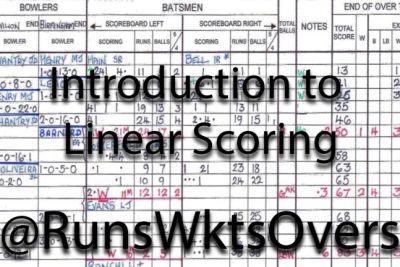Cricket, the gentleman’s game, is not only about bat and ball but also about the intricate art of scoring. From the traditional manual scoring to the modern electronic systems, cricket scoring techniques have evolved over time, ensuring accuracy and efficiency. In this article, we delve into the various methods used to keep track of runs, wickets, and statistics, highlighting the importance of these techniques in the game of cricket. Join us as we unravel the fascinating world of cricket scoring and its undeniable role in shaping the sport we all love.
What are the methods to score runs in cricket?
Cricket, a popular sport played worldwide, offers various ways to score runs during a team’s batting innings. There are primarily three fundamental methods to accumulate runs: running between the wickets, boundaries, and extras. Among these, the most prevalent approach is when the striker successfully strikes the ball with their bat, allowing both batsmen to swiftly change ends of the pitch through running between the wickets.
Running between the wickets forms a crucial aspect of scoring runs in cricket. As the batsmen execute a well-timed shot, they dash towards the opposite ends of the pitch, completing a run. This continuous running can lead to multiple runs being accumulated, contributing significantly to a team’s overall score. The skillful coordination and quick decision-making of the batsmen are paramount in maximizing the number of runs obtained through this method.
Boundaries, such as fours and sixes, are another thrilling means of scoring runs in cricket. When a batsman strikes the ball powerfully and it crosses the boundary rope without touching the ground, four runs are awarded. Similarly, if the ball clears the boundary directly, without a bounce, six runs are added to the team’s score. These boundary shots not only boost the run rate swiftly but also captivate spectators with their spectacular display of skill and power.
Apart from running between the wickets and boundaries, extras also contribute to the overall score in cricket. Extras are runs awarded to the batting team due to mistakes made by the fielding team, such as no balls, wides, byes, or leg byes. These additional runs can prove vital in close matches, where every run counts. Therefore, while striving to score runs through their batting prowess, teams also keep an eye on capitalizing on any extras offered, maximizing their chances of victory.
How is a score marked in cricket?
In cricket, marking a score is crucial to keep track of a team’s progress. The score is determined by both the number of runs scored by the batting team and the number of wickets taken by the bowling team during an innings. For instance, if a team has scored 100 runs and lost three wickets, their score would be written as “one hundred for three,” denoted as 100–3 or 100/3. This concise representation allows spectators and players to easily understand the current state of the game.
The score in cricket serves as a comprehensive summary of the ongoing innings. It combines the runs scored by the batting team with the wickets taken by the bowling team, giving a clear indication of the team’s performance. For example, if a team has amassed 200 runs and only lost one wicket, their score would be mentioned as “two hundred for one,” represented as 200–1 or 200/1. This concise and easily readable format enables everyone to quickly grasp the current situation in the game.
Maintaining an accurate scorecard is vital in cricket, and it involves recording the number of runs and wickets throughout the innings. When a team scores runs, it adds to their overall score, while the bowling team’s success is reflected by the wickets they take. By combining these two elements, the scorecard provides an instant snapshot of a team’s progress. For instance, if a team has accumulated 150 runs and lost four wickets, their score would be noted as “one hundred fifty for four,” written as 150–4 or 150/4. This concise and visually appealing representation is essential for efficient communication and analysis within the cricket community.
How can one score 7 runs in cricket?
To score 7 runs in cricket, the batsman must hit the ball with precision and agility, aiming for maximum distance and strategic placement. By timing the shot perfectly and executing a powerful stroke, the batsman can hit a six, which earns 6 runs instantly. Additionally, if the batsmen complete a successful run between the wickets, they get an extra run added to their score. Therefore, a combination of hitting a six and running a single would result in 7 runs, showcasing the importance of skill, strategy, and teamwork in achieving this feat.
Unleash Your Scoring Potential: Mastering Cricket’s Finest Art
Unleash your scoring potential and master cricket’s finest art with our expert training program. Whether you’re a seasoned player looking to enhance your skills or a beginner eager to learn the ropes, our comprehensive coaching will take your game to new heights. Our experienced coaches will guide you through the intricacies of batting, helping you develop a solid technique, improve your shot selection, and refine your timing. With personalized attention and cutting-edge training methods, we ensure that you unlock your true scoring potential and become a force to be reckoned with on the cricket field.
At our training center, we believe that mastering the art of scoring in cricket is not just about physical prowess, but also about mental strength and strategic thinking. That’s why our program goes beyond the technical aspects and focuses on building your mental resilience, decision-making abilities, and tactical awareness. We provide you with the tools to think like a true cricketing maestro, enabling you to adapt to different game situations, read the opposition’s tactics, and execute your shots with precision. With our holistic approach to training, you’ll not only become a proficient scorer but also a well-rounded cricketer who can thrive under pressure. Unleash your potential today and become a true master of cricket’s finest art.
Cricket Scoring Secrets: Boost Accuracy and Speed for Ultimate Success
Cricket Scoring Secrets: Boost Accuracy and Speed for Ultimate Success. In the world of cricket, accurate and speedy scoring is the key to achieving ultimate success. Whether you’re a professional scorer or a passionate fan, mastering the art of scoring can greatly enhance your understanding and enjoyment of the game. By employing the right techniques and adopting efficient strategies, you can ensure that every run, wicket, and boundary is accurately recorded, allowing players, coaches, and spectators to stay up-to-date with the match. From learning the intricacies of keeping score to utilizing modern scoring software, honing your scoring skills will not only boost your accuracy but also increase your speed, making you an invaluable asset to any cricketing event. So, grab your pen and scorebook, and get ready to unlock the secrets to becoming an exceptional cricket scorer.
In the ever-evolving world of cricket, scoring techniques play a vital role in determining the outcome of a match. From strategic shot placements to calculated running between wickets, players employ a range of skills to maximize their team’s score. By honing their abilities in these scoring techniques, cricketers can not only showcase their prowess but also contribute significantly to their team’s success. Whether it’s the elegant cover drive or the swift singles and doubles, mastering these techniques is an art that separates the great from the good. With each run scored, the game of cricket becomes more captivating, and the scoring techniques become a testament to the skill and precision required to excel in this beloved sport.


